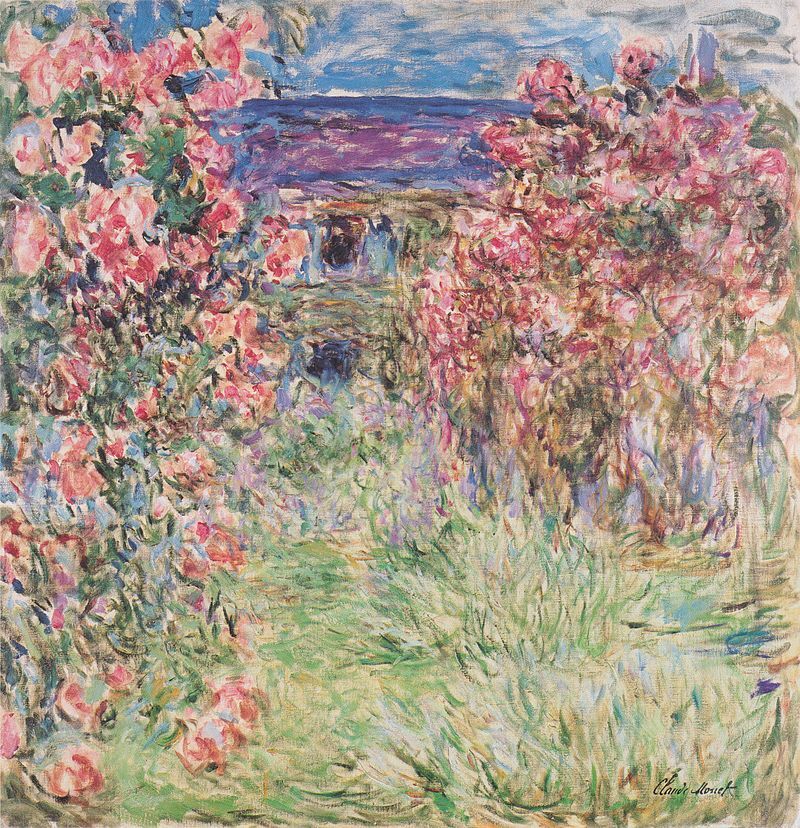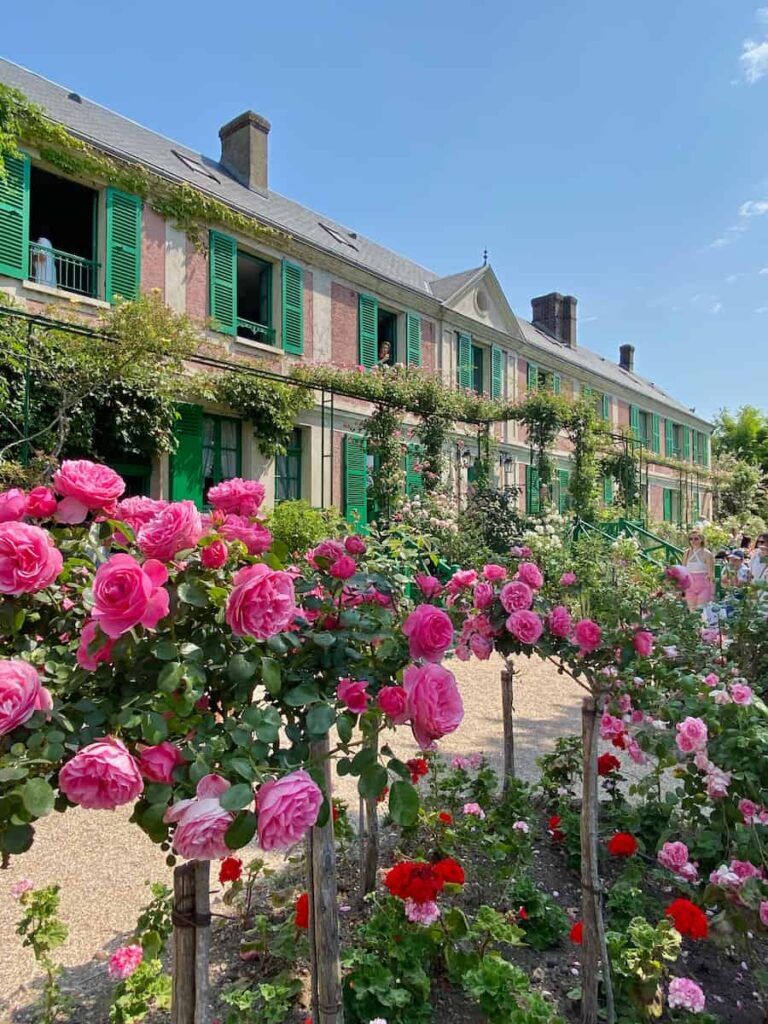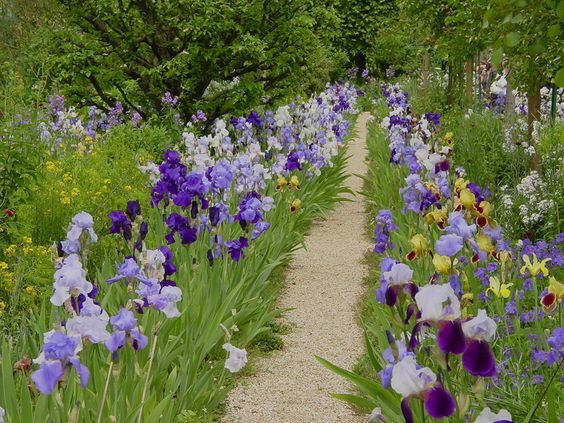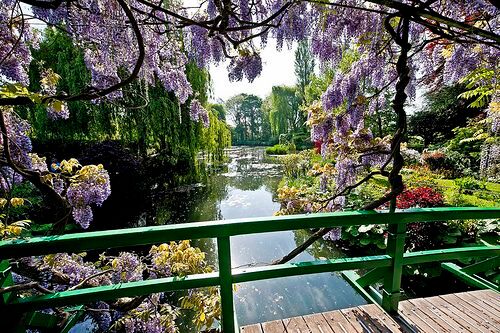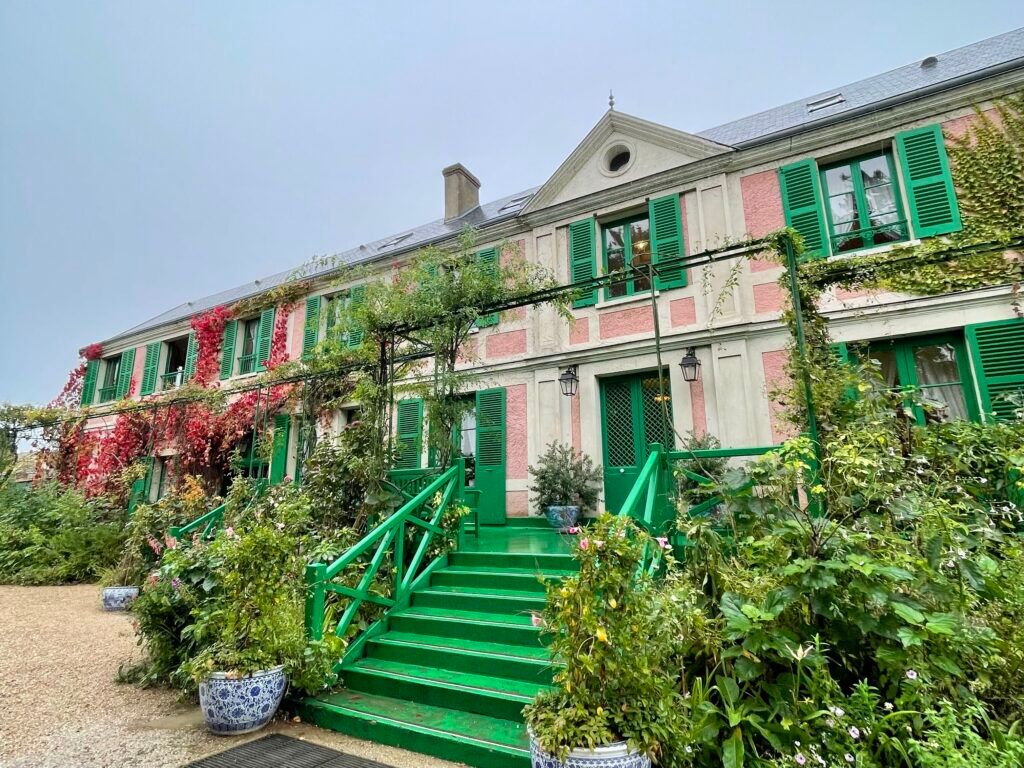Imagine walking through a living painting, where each flower petal and every water reflection seem to have been painted by the hand of Claude Monet himself. Welcome to Monet’s Garden in Giverny, an outdoor masterpiece that continues to fascinate and inspire, much like the famed painting ‘The Artist’s Garden at Giverny.’

Claude Monet’s House in Giverny
Monet’s Garden History
Behind each petal and each tranquil pond lies a story, that of an artist and his garden. Claude Monet, the father of Impressionism, did not merely capture the beauty of nature on canvas; he recreated it in his garden in Giverny.
Claude Monet was born in 1840 in Paris, but his family soon moved to the countryside, where he developed an early connection to nature. Arriving in 1883, Monet transformed a simple vegetable garden into a living masterpiece that influenced many of his most famous works. From the Water Lilies series to various studies on light and color, Monet’s garden is more than a place: it’s an endless source of inspiration.
Monet sought to capture the spontaneity of life and the effects of light in his canvases. His garden was his living laboratory, where he could observe these changes throughout the hours and seasons. The garden became an extension of his palette, and his paintings immortalized the ephemeral beauty of nature.

Flowers in Monet’s Garden in Giverny
The Species of Plants and Flowers at Monet's Garden
In Claude Monet’s garden in Giverny, every petal and leaf is carefully orchestrated to create a true natural masterpiece. Before delving into the botanical treasures that populate this garden, it’s essential to grasp its structure. Imagine a living canvas divided into two essential parts: the ‘Clos Normand,’ with its formal arrangement and flowerbeds, and the ‘Water Garden,’ an oasis of tranquility centered around the water lily pond.
In this section, we will dive into the heart of this floral diversity, exploring the species of plants and flowers that turn every corner of the garden into a delightful sensory experience. From the vibrant red of poppies dancing in the summer breeze to the gentle melody of roses blooming in spring, each area of the garden tells a unique story of nature and art.
Prepare for a journey into the realms of botany and aesthetics, where each petal is a stroke of color, and every leaf is a work of art in its own right. Welcome to the enchanted world of the plants and flowers of Monet’s garden.
Clos Normand at Monet Garden
The ‘Clos Normand’ is one of the two main parts of Claude Monet’s garden in Giverny. It is the first part of the garden that visitors encounter upon entering the property. Located in front of Monet’s house, it spans about one hectare. The garden is arranged in a somewhat formal manner, with pathways dividing it into several squares and rectangles.
Clos Normand is particularly renowned for its floral diversity. Monet planted a myriad of flowers of all kinds, shapes, and colors here. Tulips, daffodils, poppies, irises, roses, and many other flowers find their place in this garden. Monet was heavily involved in the choice of plants and their arrangement, aiming to create harmonies and contrasts of color.
The garden is a true explosion of color from spring to fall, and it served as the backdrop for several of Monet’s most famous paintings. It is in this garden that the artist drew much of his inspiration, and he spent countless hours painting it from various angles and in different lighting conditions.
Thus, Clos Normand represents not just a place of beauty and repose, but also an artistic laboratory for Monet, allowing him to explore the effects of light and color in nature.
The Water Garden at Monet Garden
The other essential part of Claude Monet’s garden in Giverny is the ‘Water Garden’ or ‘Jardin d’Eau.’ This garden is located on the opposite side of the road from the Clos Normand and can be accessed through a small tunnel beneath the road. Monet purchased this plot of land in 1893, ten years after his arrival in Giverny.
The Water Garden is famous for its water lily pond, inspired by the Japanese gardens that Monet admired. The pond is surrounded by a variety of plants, including bamboo, wisteria, and weeping willows. The most iconic feature of the garden is undoubtedly the Japanese bridge covered in wisteria, which appears in many of the artist’s works.
Unlike the formal structure of the Clos Normand, the Water Garden has a more naturalistic design, with elements blending harmoniously into one another. This is where Monet painted his famous ‘Water Lilies’ series, artworks that revolutionized the art of painting and had a significant impact on the Impressionist movement.
The Water Garden is more than just a garden; it is a work of art in itself. It reflects Monet’s artistic aspirations, as he sought to capture light, color, and atmosphere in a way never seen before.
The Species of Plants and Flowers You Can See at Monet’s Garden
Claude Monet was not only a master of painting but also a passionate gardener who transformed Giverny into a mosaic of colors and fragrances. Each season brings its own botanical palette to the garden, creating an ever-changing spectacle. Let’s explore some of the most iconic species of plants and flowers you can admire during your visit.
1. Poppies (Papaver rhoeas)
- Spring brings an explosion of vibrant red poppies.
- These delicate flowers dance in the wind, adding a touch of vivacity to the Clos Normand.
2. Roses (Rosa)
- Spring is also the time when roses unfurl their elegance.
- Monet’s garden is home to various rose varieties, each offering a range of hues and scents.
3. Irises (Iris)
- Irises bring a note of mystery with their slender petals and vibrant colors.
- Their springtime bloom is a visual delight.
4. Water Lilies (Nymphaea)
- In the Water Garden, water lilies gracefully float on the pond’s surface.
- Monet was fascinated by these aquatic plants, painting them repeatedly.
5. Wisterias (Wisteria)
- Wisterias climb along the famous Japanese bridge, creating a cascade of purples.
- Their springtime bloom adds a romantic touch to the garden.
6. Peonies (Paeonia)
- Peonies offer their opulent petals and lush colors in summer.
- Their fleeting beauty is captured in several of Monet’s works.
7. Sunflowers (Helianthus)
- Sunflowers, symbols of sunshine, illuminate the garden in summer.
- Their faces turned towards the sky bring a note of joy and vitality.
8. Bamboo (Bambusoideae)
- Bamboo frames the Water Garden’s pond, adding an exotic touch.
- Their slender stems create an atmosphere of serenity.
Explore these exceptional botanical species during your visit to Monet’s garden, and be enchanted by the variety of colors, shapes, and fragrances that inspired the artist throughout his career.
This section details some of the most striking species of plants and flowers that visitors can discover in Monet’s garden, providing an insight into the botanical richness of this magnificent place
The Importance of Floral Choices in Monet's Art Garden
Claude Monet’s floral choices in his Giverny garden are not merely botanical compositions; they are essential elements of his artistic work. Each plant and flower species, every shade of color, and each seasonal variation were carefully selected by the artist to serve as a source of inspiration for his famous Impressionist paintings. Here’s how Monet’s floral choices played a central role in his art:
1. Light and Color in Motion at Monet's Garden
-
- Monet was obsessed with the interplay of light and color in nature. The various flower and plant species in his garden provided him with an ever-evolving palette.
- By painting the same scenes at different times of the day and in different seasons, Monet was able to capture how light transforms colors and creates an ever-changing atmosphere.
2. Capturing the Ephemeral at Monet's Garden
- Impressionist art is characterized by capturing snapshots, fleeting moments. The flowers and plants in his garden provided Monet with perfect subjects for this approach.
- Poppies swaying in the wind, the changing reflections of water lilies on the water—all of this was a celebration of the ephemeral, immortalized on canvas.
3. Nature as a Source of Emotion in Monet's Garden
- Monet regarded nature as his primary source of emotion. The varieties of flowers and plants he cultivated were chosen for their ability to evoke feelings and create atmospheres.
- Roses for delicacy, sunflowers for joy, water lilies for serenity—each species brought its own emotional nuance to his paintings.
4. The Evolution of His Art
- The evolution of Monet’s garden was intimately linked to the evolution of his art. Over the years, he added new plant varieties to explore new color palettes.
- His garden was a living laboratory where he could experiment and develop his understanding of color and light.
Monet’s floral choices were far more than mere garden decorations; they were an endless source of artistic inspiration. By carefully selecting each plant and cultivating his garden as an ever-changing work of art, Monet created a space where nature and art merged in an unforgettable way.
This section highlights the crucial importance of Monet’s floral choices in shaping his Impressionist art, showing how each plant and flower species was a piece of the puzzle of his artistic vision.
The Artist's Garden at Giverny
If Monet’s garden is a living masterpiece, then ‘The Artist’s Garden at Giverny’ is one of its most iconic representations. Painted in 1900, this artwork immortalizes the splendor of the Clos Normand, the part of the garden where Monet planted a myriad of flowers in all colors. It’s not just a painting; it’s a window into Monet’s world, a world where art and nature merge into incomparable beauty. Admiring ‘The Artist’s Garden at Giverny’ is not merely a visual pleasure but also an invitation to explore this garden in person, to feel the same magic that inspired Monet.
Where to See This Painting and Similar Works
“‘The Artist’s Garden at Giverny” is part of private and public collections around the world. You can often find it in temporary exhibitions dedicated to Monet or Impressionist art. For those in Paris, the Musée d’Orsay and the Musée de l’Orangerie house other iconic works by Monet, including his famous Water Lilies series.
Importance of This Work in Impressionist Art
The impact of ‘The Artist’s Garden at Giverny’ on Impressionist art is undeniable. It embodies the key characteristics of this artistic movement: the focus on plays of light, capturing fleeting moments, and the symbiosis between man and nature. This painting is not only a masterpiece in its own right but also a perfect example of the Impressionist philosophy of seeing and representing the world.
How to Visit the Monet’s Garden with our Expert Guide
Before immersing yourself in the magic of Claude Monet’s garden in Giverny, it’s essential to plan your visit carefully. Follow these simple steps to have an unforgettable experience:
1. Plan Your Trip to Monet's Garden
- Start by deciding on the best time for your visit. The garden is spectacular in spring with its irises and blooming roses, but each season has its unique charm.
- Book with us your tickets in advance to avoid long lines at the entrance.
2. Choose Your Timing to visit Monet's Garden
- Monet was obsessed with changing light, so choose your visit time wisely. Mornings and late afternoons often offer magical lighting for photography.
3. Explore the Clos Normand
- Begin your visit with the Clos Normand, the formal flower garden in front of Monet’s house. Stroll among the flowerbeds, admire the poppies, irises, and roses depending on the season.
- Take the time to sit on the benches scattered throughout the garden to soak in the atmosphere.
4. Cross the Japanese Bridge
- Pass over the famous Japanese bridge covered in wisteria. This iconic view is one of the highlights of your visit.
- Observe the water lilies in the pond under the bridge, a scene immortalized by Monet in his paintings.
5. Relax in the Water Garden
- Head to the Water Garden on the other side of the road. There, you’ll discover the water lily pond, weeping willows, and the serenity of this space.
- Take a moment to sit by the pond for meditation and to admire the changing reflections.
6. Visit Monet’s House
- Conclude your visit by exploring Monet’s house. Discover his working studio, dining room, and his collection of Japanese prints that influenced his art.
- Learn more about the artist’s life through the displayed personal items.
7. Souvenir Shop
- Before leaving, don’t miss the souvenir shop where you can purchase reproductions of Monet’s works, books about the artist, and gifts inspired by his garden.
8. Respect the Environment
- Monet’s garden is a fragile treasure. Respect the rules, do not walk on flowerbeds, do not pick flowers, and do not litter.
- Contribute to the preservation of this natural gem for future generations.
By following these steps, you’ll be ready to have an authentic experience at the heart of Monet’s world. Take your time, soak in the beauty of the garden, and let yourself be inspired by the artist and the nature that so profoundly influenced him.
Tips for an Optimal Visit to the Monet’s Garden
Best Time of the Year
- Spring (April to June): Spring is a magical time in Monet’s garden when irises and roses are in full bloom. The explosion of colors and fragrances is a highlight.
- Summer (June to August): While summer offers a different charm with a wider variety of flowers, it can also be crowded. Try to visit early in the morning or later in the afternoon to avoid peak crowds.
- Fall (September to October): Fall brings a unique atmosphere with changing foliage colors. The garden is less crowded, providing a peaceful experience.
- Winter (November to March): The garden is closed during this period as many plants are dormant. It’s recommended to visit during the other seasons for the full experience.
Ideal Hours of the Day
- Morning: Mornings often offer the best lighting for photography. The garden is usually less crowded early in the day, allowing for a more serene experience.
- Late Afternoon: The late afternoon also provides beautiful lighting, and it’s a good time to capture the changing colors of the garden.
- Avoid Midday: Midday can be the busiest time, and the sunlight can be harsh for both photography and comfort. Consider having lunch in the nearby village during this time.
Weekday Visits
- Weekdays tend to be less crowded than weekends. If your schedule allows, plan your visit for a weekday to enjoy a quieter and more relaxed experience.
Visiting Claude Monet's garden in Giverny with our tour guide can enhance your experience in several ways:
1. In-Depth Knowledge:
- Our tour guides are expert with in-depth knowledge of the garden’s history, Claude Monet’s life, and Impressionist art in general. They can provide you with detailed information that you wouldn’t find in a standard tourist guide. Check out our Giverny day trip from Paris.
2. Artistic Context:
- Our Tour guides can help you understand how Monet’s garden influenced his Impressionist art. They can highlight famous paintings created in the garden and explain how Monet used light and color to capture the garden’s beauty.
3. Fascinating Anecdotes and Stories:
- Our Tour guides often share fascinating anecdotes and stories about Monet, his family, and life in Giverny. These narratives make the visit more vivid and engaging. We can also combine your private tour with a visit to Giverny and Versailles. (on road)
4. Personalized Answers:
- You can ask specific questions to our guides and receive personalized answers. This allows you to deepen your understanding and explore the aspects that interest you the most.
5. Time Savings:
- Our tour guides can help you optimize your time by efficiently showing you the garden’s highlights, preventing you from getting lost or waiting in queues.
In summary, visiting Monet’s garden with our tour guides can transform your visit into an educational, immersive, and enriching experience. They enable you to delve deeper into the history, art, and life of Claude Monet while providing valuable insights and unique perspectives.
Monet's Garden Conclusion
In conclusion, a visit to Claude Monet’s garden in Giverny is a journey into the world of one of the most renowned Impressionist painters. Here are the key takeaways:
- Monet’s garden is a masterpiece in itself, where nature and art harmoniously converge.
- Each season offers a unique experience, from the burst of colors in spring to the serene ambiance of fall.
- To make the most of your visit, consider the best times of the year and day, avoiding midday crowds.
- Exploring the garden with a knowledgeable tour guide adds depth to your experience, providing insights into Monet’s life, art, and the garden’s significance.
- Tour guides can share fascinating stories and anecdotes, making the visit more engaging.
- Don’t forget to respect the environment and the garden’s fragile beauty.
To truly immerse yourself in the world of Monet and gain a deeper understanding of his art, we encourage you to book a guided tour. Our expert guides will lead you through this enchanting garden, revealing its secrets and the inspiration behind some of Monet’s most famous works. Don’t miss the opportunity to create unforgettable memories in the heart of Monet’s masterpiece.
Plan your visit with us today and embark on a journey that combines art, nature, and history in one unforgettable experience.







